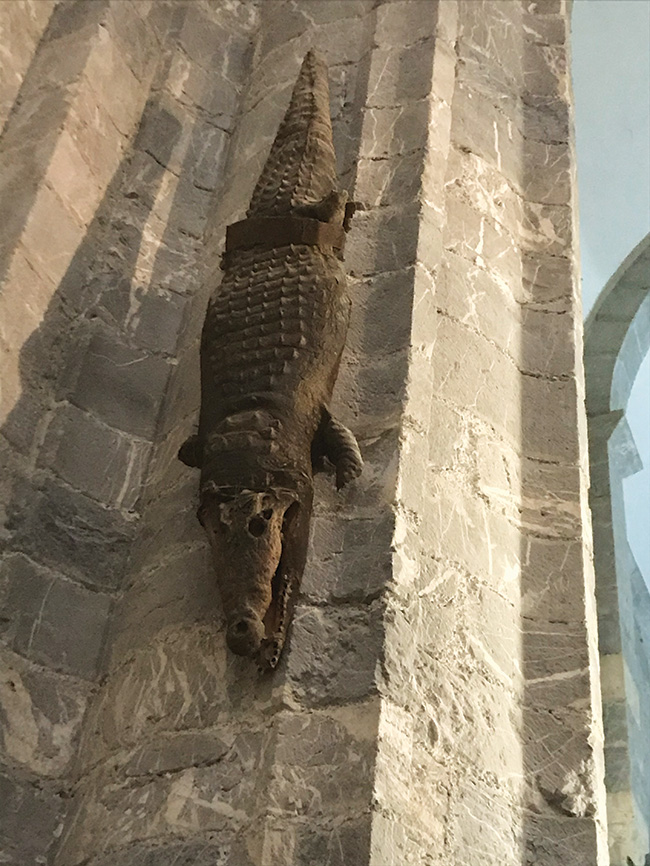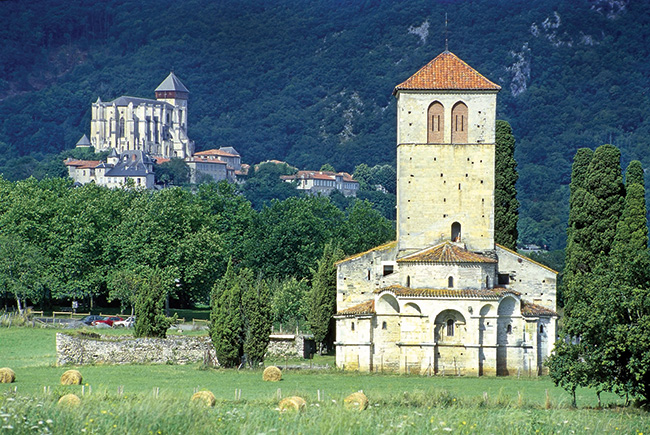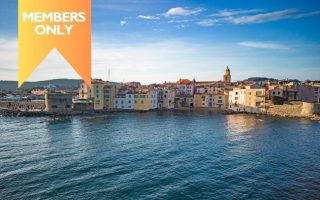Saintly Sojourn in a Plus Beau Village

Justin Postlethwaite walks through the ages during a spiritual escape in the stunning Plus Beau Village of Saint-Bertrand-de-Comminges in Haute-Garonne.
There are few holy edifices in France in which a sinister, stuffed crocodile hanging from the wall is perhaps the least remarkable of its perfectly preserved assets (cloister, oak stalls and organ, more of which later). However, the rigid reptile, vertically posed near the baptismal font at the spellbinding Notre-Dame Cathedral at Saint-Bertrand-de-Comminges (Haute-Garonne), lends a certain intriguing exoticism to the expected austere ambiance.

The legendary crocodile on the cathedral wall © Justin Postlethwaite
The most accepted croc back story – that is to say, the least fantastical – is that the animal was a trophy brought back from travels in Egypt by a local pilgrim; other more God-fearing tellings include how St Bertrand lured the beast – which roamed local valleys, enticing its victims by imitating a crying baby – to the church, where the animal was overcome with the intensity of Bertrand’s belief and went stiff as a board.
The village itself – about 120km from Toulouse and just 30km from ski and spa town Luchon – deservedly boasts the notable Plus Beau Village label. It first received the honour in 2012, but this was withdrawn in 2015 at the request of the town hall, and then reapplied in 2017. It is undeniably a jewel of the Haute-Garonne department and a vital box to tick for anyone treading the southern French Piémont Trail on the Route de Saint-Jacques de Compostelle (Way of St James) – the network of pilgrims’ hiking (or indeed cycling) trails leading to the shrine of the apostle St James the Great in Santiago de Compostela Cathedral, Galicia, Spain.

Saint-Just de Valcabrère Basilica with the cathedral in the background © Shutterstock
Seen from the road below on the Valcabrère plain, you never forget your first glimpse of the looming, perched cathedral (aka Sainte-Marie), set against its majestic Pyrenean backdrop. But first, before heading up, get your camera and wide angle lens ready and head to the village’s second ecclesiastical eye-pleaser, Saint-Just de Valcabrère Basilica. It is one of the most impressive Roman-style churches in all Occitanie and a UNESCO World Heritage site to boot. Built on a pagan necropolis and a Paleochristian cemetery and constructed in part using stones, marble blocks, bas-reliefs, columns and capitals from the original Roman city of Lugdunum Convenarum sited here, it features a beautiful sculpted door and a simple, imposing square bell tower from the 14th century. No visit is complete without a photo opportunity that frames this church in the foreground with the mighty cathedral high in the background.

Lower village buildings within the Roman amphitheatre © Shutterstock
The settlement of Lugdunum Convenarum was founded in 72 BC by Roman General Pompey, its location between mountain and plains ideal. Between 5,000 and 10,000 inhabitants (exact numbers are not known) eventually enjoyed a full range of amenities such a theatre, a temple in the forum, thermal baths and a vast market. Some of the ancient site’s ruins were unearthed from the 1920s onwards and can be spotted as you head up to the medieval village.
Saint-Bertrand-de-Comminges is accessible by car (there are a couple of free car parks – one at the bottom of the village, open all year long, the second one in the upper village, except July and August) but it is obviously most thoroughly explored by foot, up close to the stonework, including sections of Gallo-Roman ramparts, 16th-century houses, colombage (half-timbered) constructions and medieval doors.

The charming back streets of the village © Loïc Bel
Detail-spotting as you amble the labyrinth of lanes so imbued with history and atmosphere is a real joy. Unmissable are the Majou gate – the village’s principal entrance until the 18th century – with its second floor watchtower, later transformed into a prison; the former episcopal palace; and the list of taxable fish, dated 1661 and at the behest of Louis XIV, inscribed on the Cabirole gate. It tells us that on the local menu back in the day were not only river fish, such as trout, but cod from the sea, too.
Tour guides are available, to offer insight and intriguing tales beyond the usual pamphlets and maps – just head to the tourist office (and cultural centre) at Les Olivétains, the former convent in the shadow of the great cathedral. Today the village, though it only has about 250 inhabitants, is far from being ‘decayed’, as the writer M.R. James described it in his creepy 1884 ghost story Canon Alberic’s Scrap-Book, set in the village (see Boxout, right). Rather, it is welcoming and relaxed, with a handful of bijoux cafés and gift shops to cater for the many modern-day pilgrims and curious tourists who visit. My advice would be to go off-season if possible (as I did in February) just to enjoy a little breathing space and tranquillity as you take in the many memorable sights.

The cavernous interior of the cathedral © Manuel Huynh
A Cathedral for the Ages
Zipping forward through history we come to the late 11th century, and the village’s second period of influence which still largely accounts for its tourist appeal to this day. The arrival of Bertrand de l’Isle Jourdain – the grandson of the Count of Toulouse, Guillaume Taillefer – as Bishop of Comminges in 1083 saw the construction of the Romanqesue cathedral and the cloister. Crucially, several miracles were attributed to Bertrand, including that of having killed the aforementioned crocodile, meaning that after his death in 1123, pilgrim numbers grew.
The initially modest building was largely reworked during the Gothic period and then during the Renaissance, and today you can spend a good few hours exploring its many wonders – you effectively experience three churches in one. The magnificent stalls feature 66 ‘regular’ seats and one episcopal seat carved from oak and were built between 1525 and 1535 at the request of Bishop Jean de Mauléon, with the intention of isolating the canons from the constant flow of pilgrims paying homage at St Bertrand’s tomb.

Exploring the cloisters © Loïc Bel
Today, you can spend a while gazing upon the mausoleum – a huge, decorated stone shrine in his honour. Also pop into the Sainte-Marguerite Chapel to see some liturgical vestments and precious objects of worship linked to the saint. There is an entrance fee if you wish to enjoy the incredible carved details of Biblical scenes on the stalls but visiting this church within a church is a heady experience.
The same bishop also commissioned the cathedral’s mighty music maker – today deemed one of the most beautiful classic organs in Europe – tucked unusually in a corner at an angle (to serve equally the parishioners and the choir) at the back of the nave. Classified as a Historic Monument since 1840, it is raised on five fluted columns, with sculptures of rural scenes as well the labours of Hercules. It is the main inspiration and focus for the longstanding annual summer Festival du Comminges, which attracts the best organists in the world to play.
Finally, head outside for the ultimate spiritual experience in Saint-Bertrand-de-Comminges as you enter the peace of the cloister, built for the canons as a place of prayer, meeting and relaxation. There are three Romanesque sections and one Gothic one framing the courtyard – spot the pillar of the Evangelists, ornamental capitals and the tombs of the canons. The southern gallery offers views over the hillsides. From here, ponder the historic heft of this spectacular cathedral and the undeniable allure of Saint-Bertrand-de-Comminges.

Head out on the pistes © Manuel Huynh
A Pyrenees Welcome
If, this winter holiday season, you are looking for a family-friendly, cheaper ski break alternative to the Alps, with excellent access from the UK via Toulouse’s Blagnac airport, the Haute-Garonne department has plentiful options. As well as Luchon-Superbagnères – with 32km of slopes accessed from the centre town in just eight minutes by gondola – there are also the lovely bijoux resorts Le Mourtis, Bourg d’Oueil and Peyragudes. Find out more at www.pyrenees31.com/en/our-ski-resorts.
Meanwhile, for a refined meal to remember, head for the gorgeous El Almacèn about 10km from Luchon in the village of Cirès in the Vallée d’Oueil. Here you’ll find inventive and elegant wood-fired cooking with a serious welcome from Franco-Argentine couple Anne and Juan. almacen.fr

Montague Rhodes James © Wikimedia
A Ghostly Tale of Comminges
Saint-Bertrand-de-Comminges is the setting for Canon Alberic’s Scrap-Book, an 1884 horror/ghost story by distinguished scholar Montague Rhodes James (1862- 1936), who was successively Provost of King’s College, Cambridge, and of Eton College. The description of the village at the time as “a decayed town on the spurs of the Pyrenees” is far from today’s neat and tidy pilgrim’s choice. In terms of dramatis personae, the spooky work features a fictional character based on a descendant of bishop Jean de Mauléon, who commissioned so much of the stunning woodwork within the cathedral. With thanks to reader Dr Simon Cotton who alerted us to this work, which you can read free online. You can also listen to a free audio dramatisation of the work at: shadowsatthedoor.podbean.com/e/s2e03-canon-albericsscrapbook
Haute-Garonne Tourism: www.hautegaronnetourism.com
General access to the cathedral is free, €7 allows access to the choir and the cloister.
From France Today magazine
Lead photo credit : The cathedral rises majestically out of the rocky landscape © Shutterstock
Share to: Facebook Twitter LinkedIn Email
More in Haute-Garonne, Plus Beaux Villages, Pyrenees, Saint-Bertrand-de-Comminges
Leave a reply
Your email address will not be published. Required fields are marked *



